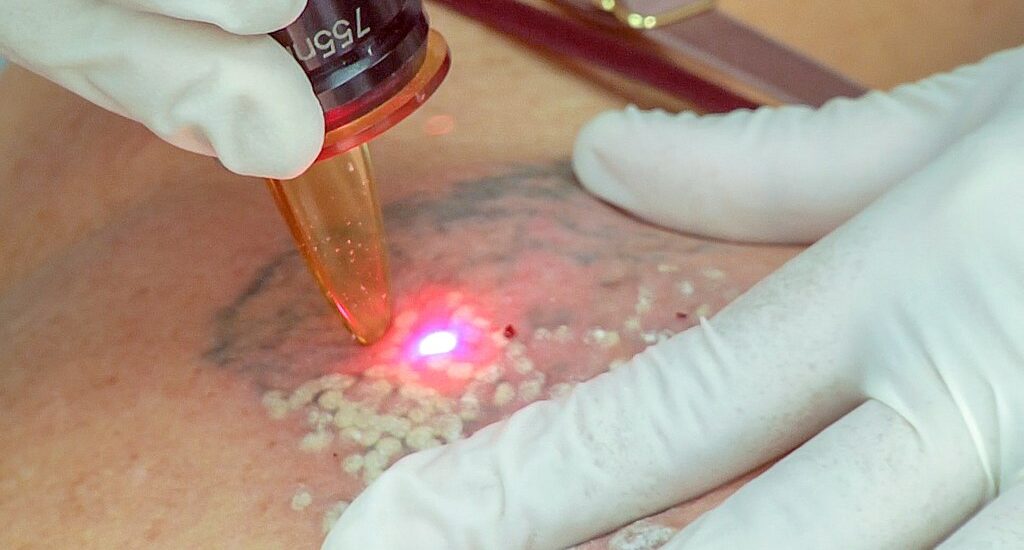If you’re seeking information on how to prevent blisters after laser tattoo removal, you’ve come to the right place. This guide will walk you through step-by-step instructions to minimize the risk and enhance your recovery process.

Table of Contents
Understanding the Risks of Laser Tattoo Removal
Before we jump into prevention, it’s important to know why blisters can form in the first place. According to a study published in the National Library of Medicine, blisters occur due to thermal damage to the skin cells, which is a natural part of the laser tattoo removal process. When the laser hits the tattoo ink, it heats up the surrounding skin cells, potentially causing blisters.
Steps on How to Prevent Blisters After Laser Tattoo Removal
The following steps will guide you on how to prevent blisters after laser tattoo removal:
Consult Your Dermatologist First
Your journey to safe laser tattoo removal should always begin with a consultation with a certified dermatologist. This is not just a formality but a vital step.
A dermatologist will assess your skin type, the complexity of the tattoo, and your medical history. They can also conduct a patch test to gauge how your skin will respond to the laser.
This information will guide the dermatologist in customizing the treatment parameters to minimize the risk of blisters and other complications.
Pre-Treatment Skincare
Preparing your skin for laser treatment is like training for a marathon; it requires thoughtful care. Begin by keeping your skin hydrated with a gentle, fragrance-free moisturizer.
You can get this Cetaphil Moisturizing Cream from Walmart.
It’s also crucial to avoid any form of sun exposure on the tattooed area for at least two weeks prior to the procedure. Sunburned or tanned skin is more susceptible to adverse laser reactions, including blistering. If you have to go outdoors, use a high-SPF sunscreen like this Aveeno Protect + Hydrate Body Sunscreen Lotion available at Walmart and cover the area with clothing.
The Day of the Treatment
On the day of the treatment, ensure you arrive at the clinic with clean skin—this means no make-up, lotions, or deodorants on the area to be treated. These substances can interact with the laser and cause skin reactions.
Your dermatologist will clean the area once more before starting the treatment and may apply a topical numbing cream to reduce discomfort. While the laser is being applied, you may feel a sensation similar to a rubber band snapping against your skin.
Remember, the cleaner and less irritated the skin is before treatment, the lower the risk of complications like blisters.
Check out these other articles…
Bumps Skin After Laser Tattoo Removal: Causes & Remedies
Brown Skin After Laser Tattoo Removal: Comprehensive Guide
Should Skin Blister After Laser Tattoo Removal? Easy Answer
How to Treat Skin After Laser Tattoo Removal: Essential Tips
Does Skin Go Back to Normal After Laser Tattoo Removal?
What Causes Blisters After Laser Tattoo Removal? Easy Answer
Should You Pop Blisters After Laser Tattoo Removal? Answered
Post-Treatment Care
After the laser is switched off, your skin’s job has just begun. Your dermatologist will usually apply a cold compress to minimize immediate swelling and redness.
It’s essential that you continue applying a cold compress at home for intervals of 10-15 minutes for the first few hours.
Generously apply an antibiotic ointment, which acts as a protective layer against bacterial infections that could lead to blisters.
You can try out this Equate First Aid Triple Antibiotic Ointment available at Walmart.
Refrain from picking or scratching the area, as this could introduce bacteria and worsen the blistering.
Monitor and Seek Medical Advice for Abnormal Symptoms
Post-treatment, your skin will be sensitive and may show some expected side effects like redness and slight swelling. However, it’s vital to know when to seek medical help.
Signs of an infected wound include increased redness, warmth, and discharge. If you see large blisters forming, or if small blisters show signs of infection like oozing or an unpleasant smell, reach out to your dermatologist immediately.
Early medical intervention can prevent complications and speed up your healing process.


